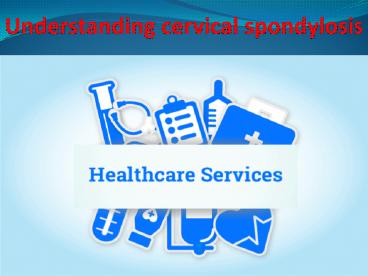Understanding cervical spondylosis PowerPoint PPT Presentation
Title: Understanding cervical spondylosis
1
Understanding cervical spondylosis
2
Neck pain is something that most commonly arises
as people age. This is because as we age, the
joints in our neck begin to degenerate. Cervical
spondylosis is the condition related to this
degeneration. In other words, it is an age
related condition that affects the joints and
discs in our cervical spine, which is in our
neck. The condition also goes by the name of
cervical osteoarthritis or neck arthritis. Age
related changes are most common in the C5-C6 and
C6-C7 segments, so this area is more prone to
neck arthritis. But what exactly are these
changes?
3
As the disc degenerate, they lose their original
biomechanical and biochemical properties. The
ability of the disc to retain water is impaired,
it loses moisture, the amount of keratin sulfat
000e increases and chondroitin sulfate decreases.
As a result, the disc loses its original height
and becomes less elastic. Facet joints are
progressively submitted to increased stresses and
instability and the uncovertebral joints become
arthritic, giving rise to pain and stiffness in
the neck.
4
Causes of cervical spondylosis
- One of the major factors which cause cervical
spondylosis as discussed earlier is age. This is
because as we age, the spinal discs becomes dry
and starts shrinking resulting in neck pain.
Apart from age, there are some other factors too
that can cause cervical spondylosis which are as
follow- - Cracks in spinal discs
- A neck injury
- Repeating the same neck movements again and again
- Indulging in activities that put extra strain on
your neck - Being inactive and overweight
5
Symptoms and sites affected
- Degenerative changes at the cervical spine are
produced in most of the population. Nevertheless,
patients usually after 40 years of age can
present with- - Axial back pain and stiffness
- Headache
- Pain in the shoulder or arms
- Signs of myelopathy
- Paraesthesia
- Weakness and clumsiness in the forearm and hand
- Exacerbations of Acute discomfort
6
The onset of symptoms is usually insidious and
they are often worse after a period of postural
steadiness. The pain may spread to different
regions including-
- The occiput
- Back of the shoulder girdle
- The interscapular area
- One or both upper limbs
7
Imaging
- X-rays show narrowing of one or more
intervertebral spaces with bony spur formation at
the anterior and posterior margins of the disc.
Loss of the normal lordotic curve or even
inversion might be found. - MRI is more sensitive to the whole degenerative
process showing details of disc, facets,
vertebrae and ligamentumflavum, changes which are
not otherwise visible. It is more reliable for
the neutral structures, showing the degree of
compromise of the spinal cord and whether or not
the clinical picture is due to nerve root
compression
8
Treatment
- Analgesics and anti-inflammatory medication can
be prescribed to control acute and exacerbating
pain. - Heat and massage are often soothing.
- Restricting neck movements with a collar is an
effective treatment during neck pain. - Physiotherapy is a very important part of the
treatment strategy, which includes exercises to
optimize the range of motion. - Prolonged use of cervical collar or brace may be
detrimental.
9
For original source of this PPT, please click or
open below link https//vardaanhospital.net/

